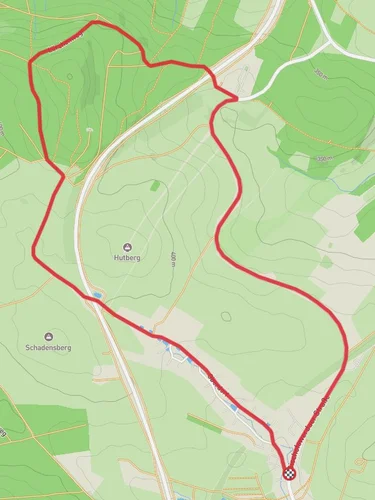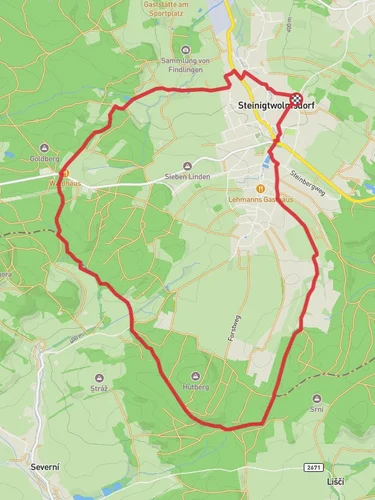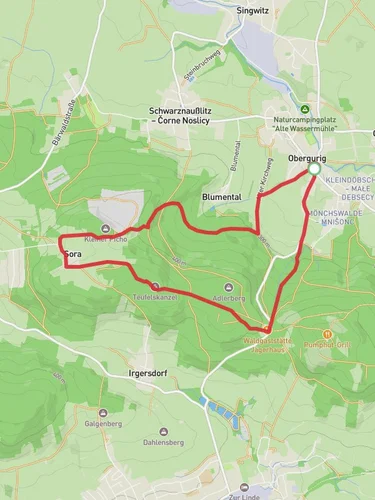110.7 km
~5 day
2409 m
“Embark on the Oberlausitzer Bergweg for a historic and scenic trek through Germany's Upper Lusatia.”
The Oberlausitzer Bergweg, spanning approximately 111 kilometers (69 miles) with an elevation gain of around 2400 meters (7874 feet), is a captivating journey through the scenic Upper Lusatia region of Germany. Starting near the historic town of Bautzen, the trail is a point-to-point adventure that meanders through the rolling hills of the Zittau Mountains, offering hikers a medium difficulty trek that can be both challenging and rewarding.
Getting to the Trailhead
To reach the starting point of the Oberlausitzer Bergweg, hikers can travel to Bautzen, which is well-connected by public transport. The nearest major city with an airport is Dresden, from where you can take a train or bus to Bautzen. If driving, Bautzen is accessible via the A4 motorway. Parking is available in the town for those who wish to leave their vehicle before embarking on the trail.
Navigating the Trail
Hikers can rely on the HiiKER app for detailed maps and navigation assistance throughout the journey. The trail is well-marked with signage, making it easy to follow the designated path without straying off course.
Trail Highlights and Landmarks
As you set out from the vicinity of Bautzen, the trail quickly immerses you in the lush landscapes of Upper Lusatia. The path takes you through dense forests, past tranquil ponds, and across open meadows, offering a diverse range of environments to explore.
One of the early highlights is the ascent of the Picho, a hill that provides panoramic views of the surrounding countryside. Further along, the trail passes through the village of Cunewalde, known for its impressive church, which boasts the tallest wooden church tower in Germany.
The trail continues to weave through picturesque villages and historical sites, including the medieval town of Oybin. Here, hikers can explore the ruins of Oybin Castle, a significant landmark with a rich history dating back to the 14th century.
Flora and Fauna
The Oberlausitzer Bergweg traverses several nature reserves, where hikers can observe a variety of wildlife and plant species native to the region. The trail's diverse ecosystems are home to deer, wild boar, and numerous bird species, including the rare black stork. The flora is equally varied, with a mix of deciduous and coniferous trees, as well as a colorful array of wildflowers in the spring and summer months.
Cultural and Historical Significance
The Upper Lusatia region is steeped in history, with a unique cultural heritage influenced by the Sorbian community, a Slavic minority in Germany. Along the trail, hikers will encounter traditional Sorbian villages, characterized by their distinctive architecture and customs. The trail also offers insights into the region's past, from ancient trade routes to remnants of fortifications and castles that once stood as symbols of power and defense.
Preparing for the Hike
Given the trail's length and varied terrain, hikers should be well-prepared with appropriate gear, including sturdy hiking boots, weather-appropriate clothing, and sufficient water and food supplies. It's advisable to plan for multiple days of hiking to fully enjoy the experience, with overnight stays in the towns and villages along the route or in designated camping areas.
Conclusion
The Oberlausitzer Bergweg is a journey through time and nature, offering hikers an immersive experience in one of Germany's most picturesque and historically rich regions. With careful planning and a spirit of adventure, this trail promises to be a memorable expedition for those seeking to explore the beauty of Upper Lusatia on foot.
Reviews
User comments, reviews and discussions about the Oberlausitzer Bergweg, Germany.
5.0
average rating out of 5
6 rating(s)






